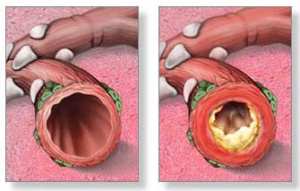

MedFriendly®


Bronchostenosis
Bronchostenosis is narrowing of a bronchus. A
bronchus is a type of small airway connected to the
lungs, which helps people breathe. When the bronchus
is narrowed, the flow of air in and out of the lungs is
restricted. The narrowing in bronchostenosis can be
due to the formation and accumulation of scar tissue or
the presence of an abnormal mass such as a tumor.
Tumors are abnormal masses of tissue that form when
cells in a certain area of the body reproduce at an
increased rate.
A normal bronchi (left) and a
narrowed bronchi (right).
FEATURED BOOK: Muller's Diseases of the Lung
Alternatively, someone can be born with a narrowing of this area. Such abnormal
narrowings of passageways in the body are also known as strictures. Bronchostenosis
can occur acutely (suddenly) such as when due to asthma. In asthma, bronchostenosis is
mostly due to inflammation.
Bronchostenosis can also be a chronic condition, meaning that it persists for a long time.
Chronic bronchostenosis can be treated with a bronchoplasty, which is surgical alteration
of the structure of a bronchus. When there is significant narrowing of a bronchus,
deflated balloons can be inserted into the bronchus and then inflated to widen the area.
This is known as a balloon bronchoplasty. Bronchostenosis comes from the Greek word
"bronchu" meaning "windpipe," and the Greek word "stenosis" meaning "a narrowing." Put
the words together and you get "a narrowing windpipe."
"Where Medical Information is Easy to Understand"™















